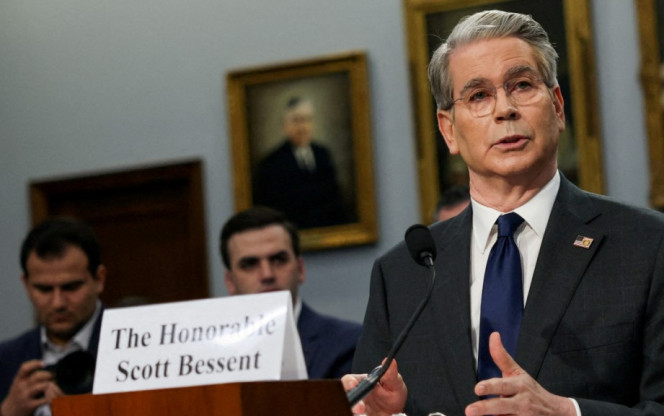China-US Expected to Meet in Switzerland to Discuss Tariffs; China Establishes 60 Billion Yuan Fund for AI; Latest Updates Within China

China-US Trade Talks: A Potential Thaw?
The ongoing trade tensions between the United States and China have taken a new turn as officials from both countries are expected to meet in Switzerland to discuss trade-related issues. According to a report by Sing Tao, US Treasury Secretary Scott Bessent will engage in high-level talks with Chinese Vice Premier He Lifeng. The meetings focus on creating the groundwork to "cool down" tensions, which have led to significant disruptions in global trade patterns. Bessent emphasized the need to "lower temperatures" to progress, suggesting a desire to reduce the impact of tariffs that have been a major sticking point.
In contrast, The New York Times article conveys that the discussions will prominently feature trade and economic issues, signaling potential movement towards de-escalation. Yet, they also highlight that tariffs have contributed to a significant drop in US imports from China, reaching a 20-year low.
Media Narratives and Expectations
Different media outlets vary in their portrayal of the objectives and expected outcomes of these talks. Sing Tao’s coverage seems more optimistic, perhaps echoing sentiments from regional stakeholders hopeful for a resolution beneficial to Asia-Pacific economies. In contrast, the New York Times maintains a cautious tone, mindful of historical complexities in negotiations between the two economic powerhouses.
Xinhua emphasizes China's stance on maintaining a balanced approach during negotiations. It highlights the Chinese government’s resolve to protect national interests and suggests a robust dialogue contingent upon mutual respect and equity. This assertive tone serves to underline China's perspective that any resolution must reflect fairness and the correction of what it perceives as unjust unilateral tariff measures by the US.
Wider Economic Implications
These trade deliberations influence multiple sectors worldwide, from consumer goods to tech. Tariffs have not only affected bilateral trade volumes but also had domino effects on supply chains. American businesses and consumers have faced increased costs, while Chinese companies have built strategic alliances to counterbalance these impacts.
Moreover, the broader geopolitical landscape is shaped by such developments, with regions like Europe carefully monitoring US-China negotiations for their cogency on trade alliances. For global markets, every statement or meeting marks a potential shift, manifesting in market movements, as seen in the immediate stock market response post-announcement of the Switzerland talks.
China’s Domestic Adjustments
Alongside these international discussions, China appears to be taking measures at home to alleviate some economic pressures stemming from the trade war. As per Xinhua, the China Securities Regulatory Commission is poised to support public companies affected by tariffs through enhanced financial regulation and assistance strategies. Such proactive approaches highlight China's dual focus on international diplomacy and bolstering domestic economic resilience.
Conclusion: Towards a Delicate Balance
The ongoing negotiations are more than mere diplomatic exchanges—they reflect crucial strategic maneuvers in a complex web of global trade networks. While optimism should be tempered with realism, these meetings represent a pivotal moment. They provide an opportunity for both superpowers to navigate a path towards a stable economic future, benefiting not just their citizens but the broader international community.
Accelerating Intelligence in Robotics
The Chinese government is actively accelerating the development of intelligent robotics as a strategic priority. According to a recent report by Xinhua, various initiatives are being introduced from central to local levels to cultivate and develop intelligent robots. The goal is to drive a new wave of innovation within the robotics industry, aiming to expand the market scale to 400 billion yuan by the end of the '14th Five-Year Plan' period.
One interesting example mentioned is a robot called "Summer," which was demonstrated to engage with an elderly person at a Shenzhen nursing home, highlighting the social applications of robotics. Moreover, initiatives such as the 'Smart Education Robots' showcase in Shenzhen reflect a focus on integrating AI into real-world environments, helping to close the gap between technological development and practical application.
Policy as a Driving Force
The robust policy framework seems to be a definitive force driving this surge in intelligent robotics. China's establishment of a National Artificial Intelligence Fund, worth 60 billion yuan, aims to accelerate investment in related projects. This aligns with the Ministry of Industry and Information Technology's push to integrate robotics into traditional industries and enhance industrial chains.
The strong governmental support implies a strategic priority of not only expanding domestic capabilities but also increasing global competitiveness. This proactive stance contrasts with some Western nations where bureaucracy and debate often slow down policy implementation.
Shanghai's Business Environment: A Global Benchmark
The recent report by the World Bank highlighted Shanghai's business environment, revealing that the city achieved top global standards in 22 evaluation criteria, as reported by The Paper. This accomplishment places Shanghai ahead of other economic powerhouses, like Singapore, which only topped 10 criteria. Shanghai's commitment to creating a favorable business environment is evident in their initiatives detailed in the "Optimization of Business Environment 8.0 Plan", which prioritizes reforms in standards and execution through proactive economic measures.
Shanghai's strides in making their local environment a model for international business reflect a broader strategy of enhancing economic competence and service reliability. The city's capacity to consistently improve, aiming for "better, not just best", underpins its ambitions. It's a compelling narrative of a city not resting on its laurels but pushing for innovation and efficiency. This continuous transformation impacts global investors looking for stable opportunities.
Challenges and Governance in Xinjiang: Scrutinizing Local Leadership
In stark contrast, an investigation involving Song Quanwei, deputy head of the Xinjiang Production and Construction Corps' (Bingtuan) project, sheds light on governance challenges within China's regional development programs, reported again by The Paper. Accusations against him involve serious violations of discipline, reflecting vigilance in regulatory oversight within these projects aimed at regional development. The scrutiny highlights the attempt to maintain integrity and transparency in governance, albeit revealing vulnerabilities in the process.
This narrative emphasizes China's commitment to clamping down on corruption, vital for sustaining the credibility of their developmental initiatives that are crucial for strategic regional stability. However, it also casts light on the continuous struggle to reconcile rapid development with stringent oversight.
Water Scarcity in Shaanxi: Coping with Environmental Stress
Finally, environmental challenges in Shaanxi were addressed as residents face escalating water shortages due to prolonged drought conditions, as covered by The Paper. Reports from various counties stress the need for careful water management and conservation strategies. Communities are urged to utilize privately drilled wells and adhere to strict water-saving measures amidst the dire forecasts indicating no immediate relief from drought.
This scenario not only highlights the extreme weather patterns affecting various parts of China, but also how local governments and societies adapt to these adversities. The emphasis on communal action and resourcefulness reflects an alignment with China's broader environmental goals, even as these communities grapple with immediate challenges. Such events are pivotal in shaping policy adaptations and reinforcing the importance of sustainable practices on a national level.

